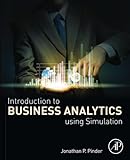Introduction to business analytics using simulation
Material type: TextPublication details: USA Elsevier 2017Description: xiii, 434 p. 23 cm ; PbkISBN:
TextPublication details: USA Elsevier 2017Description: xiii, 434 p. 23 cm ; PbkISBN: - 978-0128104842
- 658.401 PIN
| Item type | Current library | Collection | Call number | Status | Date due | Barcode | |
|---|---|---|---|---|---|---|---|
 Books
Books
|
H.T. Parekh Library | GSB Collection | 658.401 PIN (Browse shelf(Opens below)) | Available | B2375 |
Alpha/2413/20 Apr 17/Rs.6819/-
Chapter 1: Business analytics is making decisions
Chapter 2: Decision-making and simulation
Chapter 3: Decision Trees
Chapter 4: Probability: measuring uncertainty
Chapter 5: Subjective Probability Distributions
Chapter 6: Empirical probability distributions
Chapter 7: Theoretical probability distributions
Chapter 8: Simulation accuracy: central limit theorem and sampling
Chapter 9: Simulation fit and significance: chi-square and ANOVA
Chapter 10: Regression
Chapter 11: Forecasting
ntroduction to Business Analytics Using Simulation employs an innovative strategy to teach business analytics. It uses simulation modeling and analysis as mechanisms to introduce and link predictive and prescriptive modeling. Because managers can't fully assess what will happen in the future, but must still make decisions, the book treats uncertainty as an essential element in decision-making.
Its use of simulation gives readers a superior way of analyzing past data, understanding an uncertain future, and optimizing results to select the best decision. With its focus on the uncertainty and variability of business, this comprehensive book provides a better foundation for business analytics than standard introductory business analytics books. Students will gain a better understanding of fundamental statistical concepts that are essential to marketing research, Six-Sigma, financial analysis, and business analytics.
There are no comments on this title.


